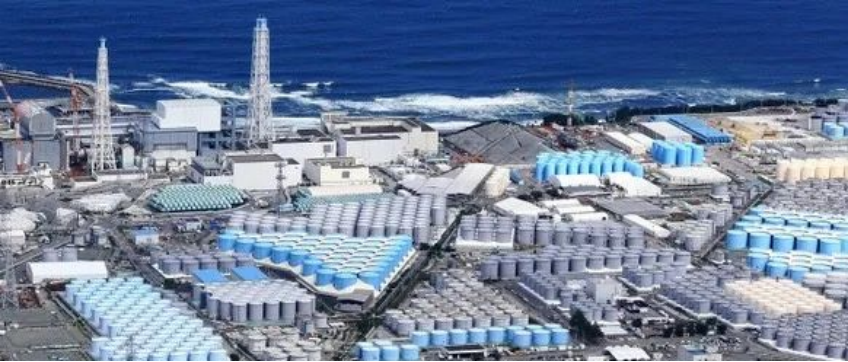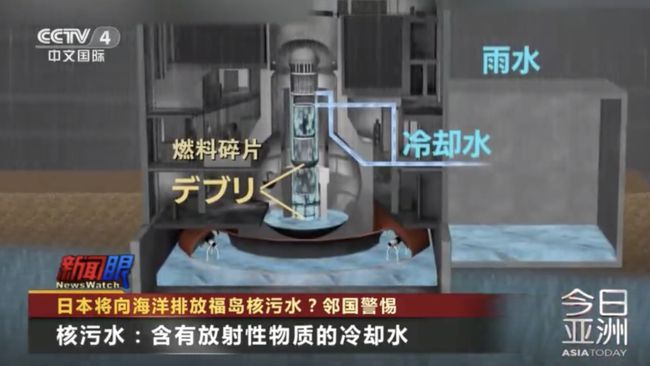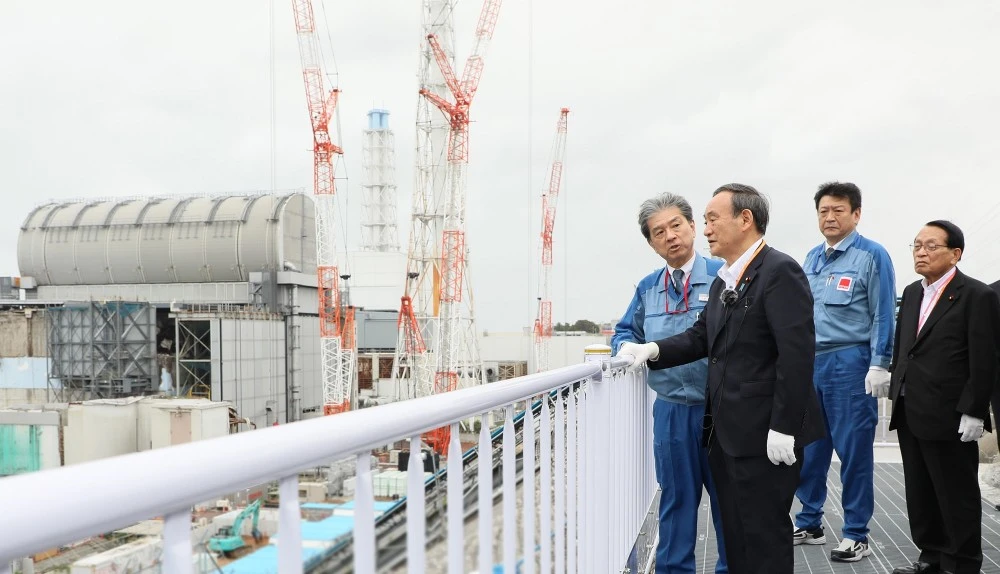The problem can only be covered up, but it will never go away on its own. This is a dilemma that humans must face truthfully.
It is almost 10 years since the Fukushima nuclear accident crisis in Japan in March 2011. In 10 years, we may have forgotten this incident. However, according to the news recently announced by the Japanese media, the Japanese government has decided to discharge more than 1 million tons of nuclear waste water containing radioactive tritium stored in the Fukushima Daiichi Nuclear Power Plant directly into the Pacific Ocean.
It turns out that after the accident, the nuclear waste that sank to the bottom of the nuclear reactor must be cooled with a large amount of cooling water. Coupled with the large amount of rainwater and groundwater infiltration, about 180 tons of high-concentration radioactive nuclear contaminated water will be produced every day. As of September this year, about 1,000 steel storage tanks have been built around the nuclear power plant to store 1.23 million tons of nuclear waste water.
From the picture, we can feel this scene for ourselves. According to the data provided by the Japanese government, these storage tanks will be filled up as soon as 2022. In the words of the person in charge of the Fukushima nuclear power plant, they have no choice but this method (discharge into the sea) will work.
But once this plan was announced, it was first resolutely resisted by the Fukushima Local Fisheries Association and the Japan Fisheries Federation. This is tantamount to bringing another devastating blow to the local fishery production that has just resumed. Similarly, this move has received strong attention from the Chinese and South Korean governments. We urged Japan to consider it carefully, while South Korea said that if Japan really acts, they will file a lawsuit in domestic and foreign courts. For the general public, we are naturally also very concerned about the impact of this sewage on the marine environment, especially marine aquatic products, if we eat South American prawns in the future, it may not be fragrant.
At the beginning of the year, there was a new coronavirus that spread all over the world with the flow of globalization. In the future, there may be nuclear radioactive materials that travel across the Pacific Ocean with ocean currents. People who have just enjoyed peace, stability and rapid development for more than ten years may really have to worry about this rapid development. What a changing world might look like in the future.
Regarding nuclear energy and the possible nuclear crisis, just like the sword of Damocles, it not only brings huge kinetic energy to mankind, but also a huge threat on the head. This time, we will mainly talk about an unfamiliar topic. The nuclear threat is a bit far away from us.
A history of nuclear energy development is also a history of controversy over nuclear energy preservation
As we all know, after Einstein's mass-energy conversion formula and Fermi's chain nuclear reactor model were discovered, it coincided with the Second World War. Once nuclear energy was discovered, it was used in the development of atomic bombs. The two devastating atomic bombs dropped on Hiroshima and Nagasaki, Japan, on the one hand accelerated the end of World War II, on the other hand, they opened up the Cold War period of nuclear threat.
With the end of World War II, nuclear energy was not only used to deter nuclear weapons in the game between major powers, but also began to be used to create stable and reliable nuclear reactors, and began to transmit electricity for civilian purposes.
Since the 1950s, the world's first commercial nuclear power plant, commercial nuclear power reactors began to appear in many countries around the world. As of 2014, only 8 countries in the world have the ability to manufacture nuclear weapons, but 31 countries have 445 commercial nuclear power reactors with a total installed capacity of 387GW, which is more than three times the power of all sources in France and Germany more than. In recent years, the global and reactor construction has entered a period of acceleration.
At present, the top five nuclear power generation countries—the United States, France, China, Russia, and South Korea, in order of ranking, account for 70% of the world’s total nuclear power generation. The United States and France account for 47% of the world’s total nuclear power generation. %, again accounting for nearly half. Three-quarters of electricity in France comes from nuclear power, and nearly one-quarter of electricity in Japan comes from nuclear power. For countries in short supply of traditional fossil energy, nuclear power is undoubtedly the best solution.
But with the expansion of nuclear energy, the issue of nuclear energy storage and abolition has also been discussed. The most deadly problem of nuclear energy is that once a nuclear reactor has a problem, serious nuclear leakage and nuclear radiation will seriously endanger the surrounding areas and even the safety of human life.
Murphy's law tells us that things to worry about always happen. Up to now, mankind has suffered three nuclear leaks, namely the Three Mile Island nuclear leak in 1979, the Chernobyl nuclear leak in 1986 and the Fukushima nuclear leak in 2011.
The Three Mile Island nuclear accident is the most serious nuclear accident in the history of the United States, and was rated as the fifth level by the international nuclear incident classification. Although the accident did not cause major public safety and environmental disasters, it greatly affected the local economy of Pennsylvania and also affected the construction of nuclear energy in the United States during this period.
The Chernobyl nuclear accident was a major disaster in human history. It became the first major accident in the history of nuclear energy to be rated as a seventh-level event by the International Nuclear Event Scale. At that time, the continuous explosion of the No. 4 reactor of the Chernobyl nuclear power plant caused a fire and emitted a large amount of high-energy radiation into the atmosphere. The radiation dose released was more than 400 times that of the atomic bomb exploded on Hiroshima during World War II. In the end, tens of thousands of people died of radiation and tens of thousands of people suffered from cancer, and the economic loss was as high as US$200 billion.
The third major accident was the Fukushima nuclear leak in 2011. After a series of chaotic firefighting and emergency measures, the nuclear leak continued to deteriorate, from the original level 5 to the same level as Chernobyl. At level 7, in the end, the melted nuclear reactor core can only be cooled by continuous water injection to cool down the temperature.
In the face of the Chernobyl nuclear accident at that time, the Soviet Union had no effective means. It could only seal the entire reactor with concrete pouring by "sealing the coffin", but it did not solve the high amount of radiation inside. The problem is that as time goes by, the cement weathers, and the current Ukrainian government must re-face the threat of nuclear leakage.
Japan has decided to completely resolve Fukushima’s nuclear radiation threat, and plans to demolish the entire nuclear power plant and rebuild it into a park around 2040. But the key issue is to take out the nuclear fuel rods that have sunk into the bottom of the furnace, and clear the roadblocks that enter the bottom of the furnace. It is close to nuclear fuel, which is far beyond the standard that humans can bear. Japan can only hope that professional robots that can complete such complex tasks. But it has not been achieved so far. In the end, only nuclear waste water is continuously extracted every day.
The problem of nuclear wastewater treatment, which is almost full, is now facing the Japanese government and people.
Whether to row or not, this is a dilemma
Why didn't the Japanese government discharge nuclear waste water into the sea from the beginning? In the beginning, these nuclear waste water contained a variety of radioactive materials. TEPCO, the party responsible for the accident, had to use a multi-nuclide removal device for filtering treatment. However, this device could not effectively remove the radioactive tritium in the nuclear waste water, so they only The water can be stored first to remove radioactive materials.
Why is the Japanese government now agreeing to discharge these nuclear waste water into the sea? The official statement is that there is currently no technology in the world that can remove tritium from nuclear waste water, and other nuclear power plants also adopt the method of directly discharging nuclear waste water with tritium into the sea. Therefore, they believe that they will also have the right to do so. According to the plan, the drainage operation will start in 2022 and last for several years, that is, a little bit of discharge into the sea.
In addition, the official also gave a scientific explanation that tritium has low toxicity and the half-life of radioactivity is only 12.43 years, which will not cause much harm to the marine environment and human health.
However, these explanations did not exchange the trust of the outside world, let alone the recognition of local fishermen in Fukushima. As a direct stakeholder, the reaction of fishermen is very normal. Once the nuclear power plant continues to discharge wastewater, it will have a negative impact on the local fishery, and the fishery that has finally recovered will be in trouble for the second time.
The mistrust of the outside world is that perhaps no one knows whether there are other radioactive substances remaining in the wastewater besides tritium. This is because the Japanese government and TEPCO not only had many "dishonest" actions in the handling of the Fukushima nuclear accident, but also in the previous nuclear accidents, there were also many cases of data falsification and false reports. . According to Hain's Law, before every major accident, there must be many minor accidents hidden. The reason for major accidents is that they did not learn lessons from previous accidents or did not have the awareness to face and solve problems truthfully.
Now that TEPCO has spent close to 200 billion U.S. dollars to deal with the Fukushima incident, it is difficult not to worry that they are trying to reduce investment and persuade the government to agree to discharge the pollution to the sea.
According to media reports, former Japanese Prime Minister Yukio Hatoyama posted on Twitter that he believed that the Fukushima nuclear power plant should choose a larger space to continue to store the storage tanks in order to wait for proper technical solutions. Some Japanese people also questioned whether Japan should sacrifice its international reputation, leave the trouble to others, and abandon its nine-year effort (storing nuclear waste water).
On the one hand, the Japanese government and enterprises are eager to get rid of the thorny troubles, on the other hand, the people are concerned about their own interests and "face". In addition, with the approach of the Tokyo Olympics next year, because some competitions are only 60 kilometers away from the abandoned factory in Fukushima, the Japanese government also needs to consider the safety of the Olympic games, as well as the pressure of public opinion around the world, whether to row or not, how to row, This will be a major problem that Japan's new appointment Yoshihide Suga must solve before the Olympics.
Chernobyl and Fukushima, the security alarm that has been ringing
Will Japan eventually discharge this million tons of nuclear waste water? Most definitely. But a reasonable solution should not be arbitrarily. As the United Nations, China, the United States and other countries are worried, Japan’s “risky” behavior will increase the risk of nuclear radiation pollution in the global ocean. As proposed by the Chinese government, “The Japanese government should thoroughly assess the possible impact of the Fukushima nuclear power plant’s tritium-containing wastewater treatment plan, and disclose information in a strict, accurate, open and transparent manner in a proactive, timely manner, based on full consultation with neighboring countries. And make decisions carefully."
That is, on the one hand, Japan must formulate a more detailed emission plan, negotiate with neighboring countries, and formulate a preliminary plan to immediately stop emissions once a significant nuclear radiation risk is detected. On the other hand, Japan must have open and transparent information on nuclear waste water testing to ensure that other radioactive substances are effectively removed.
At the same time as economic globalization, the global natural environment has also become a resource that a few countries can use and grab at will, but the ocean may become the largest "commons" on the planet. And if all countries treat these global environmental crises with a zero-sum game mentality, the ocean may also become a victim of the "tragedy of the commons."
Finally, we may want to ask: "Are we going to stop the development and utilization of nuclear power?" Of course not. In the face of a new round of energy reforms in mankind, it is the general trend to replace fossil energy, and nuclear energy is still the most potential and environmentally friendly energy solution.
As for security, our country has never stopped. In the 30 years since Chernobyl, our country has mastered the new generation of nuclear power technologies "Hualong No. 1" and "Guohe No. 1" with completely independent intellectual property rights after technical tackling, using almost everything that can be done. Safety measures have become one of the safest nuclear power plants in the world.
After experiencing the devastating Chernobyl incident and the Fukushima incident with unpredictable consequences, mankind should adopt a more rigorous and serious attitude towards the development and use of nuclear power. It is hoped that Chernobyl’s "tombstone" only represents the past, and that the Fukushima nuclear power plant will eventually be built into a park that is restored to life.
This is the result of our hope.






No comments:
Post a Comment